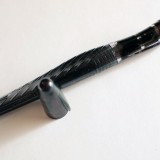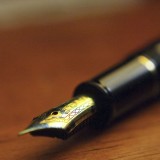Writing on a Palm Pilot
OK, they haven’t been called “Palm Pilots” for years, but I find it helpful to distinguish between the electronic device and the inside of the hand, so I say “Palm Pilot”. So sue me. Meanwhile, let’s talk about writing on your Palm brand personal digital assistant device thingy, ok?
I’m a longtime Palm user. I got my first one back in 2000 when I was working for a dot-com startup (that went dot-boom later on) while going to graduate school, full-time. I desperately needed to get my schedule in order.
But I soon found that the Palm was really well-adapted to writing on the go. The handwriting-based text entry was useful for writing on the New York subways — I could write a whole 3-4 page essay on the way to work with one elbow wrapped around a pole or hung through a handstrap. And for longer sessions where I could sit down, a couple of companies made nifty foldable keyboards you could attach to the Palm.
Although Palm’s heyday seems to have come and gone, a Palm is still a useful little writing device. There are excellent word processors available, such as Documents to Go, which allows you to write fully-formatted documents, save in Word format, and swap files back and forth with any version of Office. The PDA-only devices (like the Palm TX) still have handwriting support (Treo users like me have to use third-party software like MobileWrite). And there are both infrared keyboards like the Palm Universal Wireless Keyboard and Bluetooth keyboards like the iGo Stowaway that allow you to have a full keyboard to work on wherever you can find a flat surface to write on.
Palm’s can be easily extended with all sorts of third-party software that you might find useful as a writer, from bibliographic reference managers to full relational databases to outliners to memopads. Most of them can also access the Internet, via either a built-in cellphone, an external cellphone connected via infrared or Bluetooth, or built-in Wi-Fi, which means you have access to online resources like Wikipedia, too.
I wouldn’t recommend using a Palm for writing that Tolkein-esque fantasy trilogy you’re working on, but for short pieces (or parts of longer works) it’s pretty handy — easy to carry, easy to use, and with a better battery than most laptops. Jeff Kirvin used to maintain a site for Palm-based writing; the site’s been gone for years now, but the Writing on Your Palm archives are still up if you want some useful tips. There’s also a fairly active Writing on Your Palm Google group committed to mobile writing (including writing on Windows mobile and Apple devices). Check them out if you’re interested in using a Palm to extend your writing life.






For entering text on a Palm or similar device, I highly the Fitaly addon. As you see at the link, the Fitaly is a keyboard layout that’s optimized for single-digit or stylus input: commonly used letters are grouped, and a few techniques (like click-and-slide to capitalize a letter) makes for even faster input. You can almost reach typing speed on this thing once you’re used to it—and it takes a very little time to learn. I’ve used it on the Palm and the Pocket PC and consider it essential.
Oops: “highly recommend”
LeisureGuy: I tried out Fitaly years and years ago, on my then-new Handspring Visor. I never got the hang of it, but I know some people swear by it. The idea, for those unfamiliar, is that FItaly replaces the regular Palm popup keyboard with one optimized for typing using a stylus. The letter you use the most are in teh center, and the letters statistically most likely to be together are positioned near each other. Sort of a Dvorak keyboard for working on the Palm’s touchscreen.
It took me about a week to work up speed, so there’s definitely a learning curve. I didn’t make any special effort to learn the position of the letters, just looked for the next letter and within a couple of days knew all the common letters. Z and X took longer. 🙂 It is definitely worth an experiment.
I used to enjoy writing on my Psion Series 5 — it had all the portability and functions of a PDA, and came with a decent word processor. The keyboard was nice, too.
Could never get the hang of writing on a Palm PDA, even with the folding keyboard that I bought.
My Palm Treo has come in handy when a blog idea pops in my head while I’m riding on the bus. I either use the email function or Documents on the Go.
I once used my Palm M130 a lot, even got the external keyboard, but it was unfortunately hard-wired. I abandoned Palm when I was once travelling with no access to a power point to rejuice the battery — I lost LOTS of information and programs that I had paid for. I also learned that switching out an old battery is difficult on the earlier Palms. I guess the new ones do better.
Along PDA lines, SoftOffice has just released an updated version for its very fine office suite for Pocket PC.
Personally, I’m beginning to think about buying the $300 mini-laptop by Asus computers, which keeps its price down by installing Linux rather than Windows. I’m beginning to learn that a writer can do just fine on Linux.
I’ve been using Palm and Windows Mobile devices for about as long as you, but writing 3-4 pages on a PDA almost seems Tolkienesque to me; with all those years of use I have reasonable speed, but because I get frustrated that I can’t reach my typing speed I give up and stick to writing nothing longer than an SMS 😉 Same reason I don’t write on paper anymore, other than my to-do list. Pathetically impatient mindset, eh?
Tom: I’ve been salivating over those Asus EeeePCs since last fall when I first started hearing announcements. HP has an even nicer (but much more expensive) tiny notebook, and several other companies are coming out with them, too.
Some advantages of a Palm are: long battery life, instant-on (no boot-up time), smaller (obviously), and made for quick reference. But one of those tiny laptops might be compelling enough to overcome some of those plusses.
Joel: I rarely write more than a page or two on paper because I hate the double-work of typing it up, although that’s often a good chance to revise. A Palm is a terrible interface for editing, because you see so little of the document at a time, but I find it’s a pretty good interface for just writing, especially in the kinds of situations where taking out a laptop is pointless, like sitting 10 minutes before an appointment or between obligations.
Dustin: re the Asus EeeePCs. I recently went up to visit my parents and it turned that my dad, mother, two of my sisters and one of my brothers had one. Weird, eh? Anyway, the first two broke within the first three weeks; not sure if they’re brittle or the kids are careless, probably the latter, but let’s just say these aren’t the laptops that will survive a small drop or being sat on 😉 Otherwise, they seem great.
I love my Palm. For wordprocessing, I use Word Smith which integrates with Word.
Amazing, found your page on Yahoo!.Glad I finally tested it out. Not sure if its my Chrome browser,but sometimes when I visit your site, the fonts are really small? Anyway, love your site and will return.See Ya